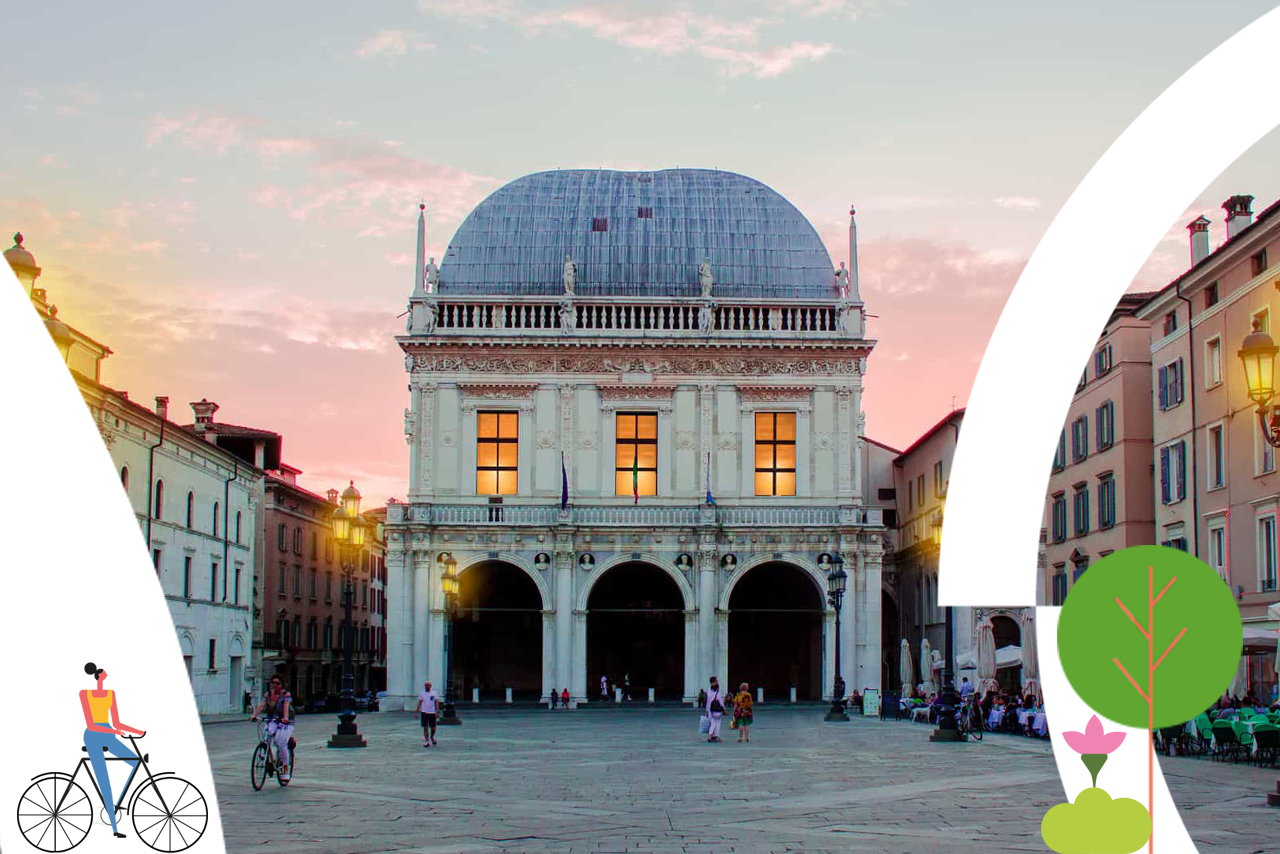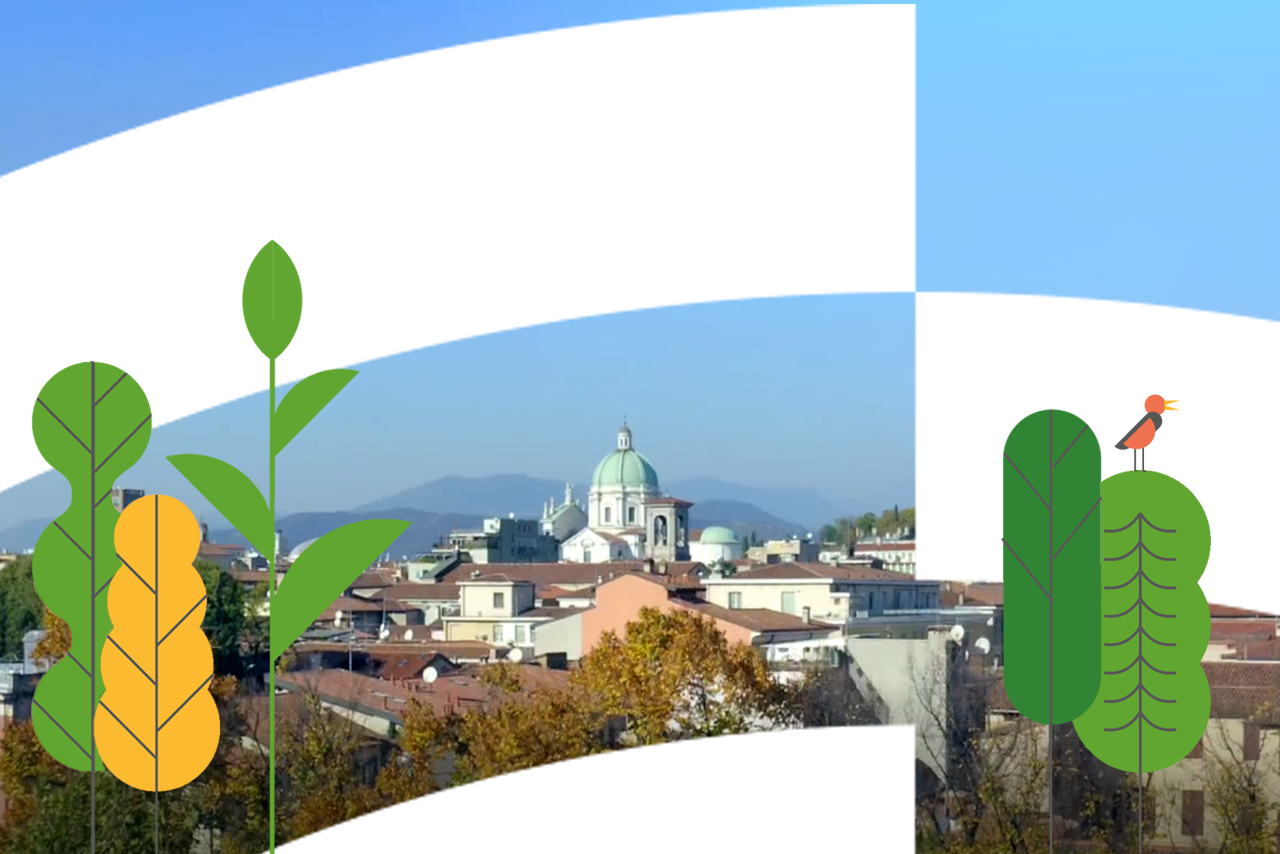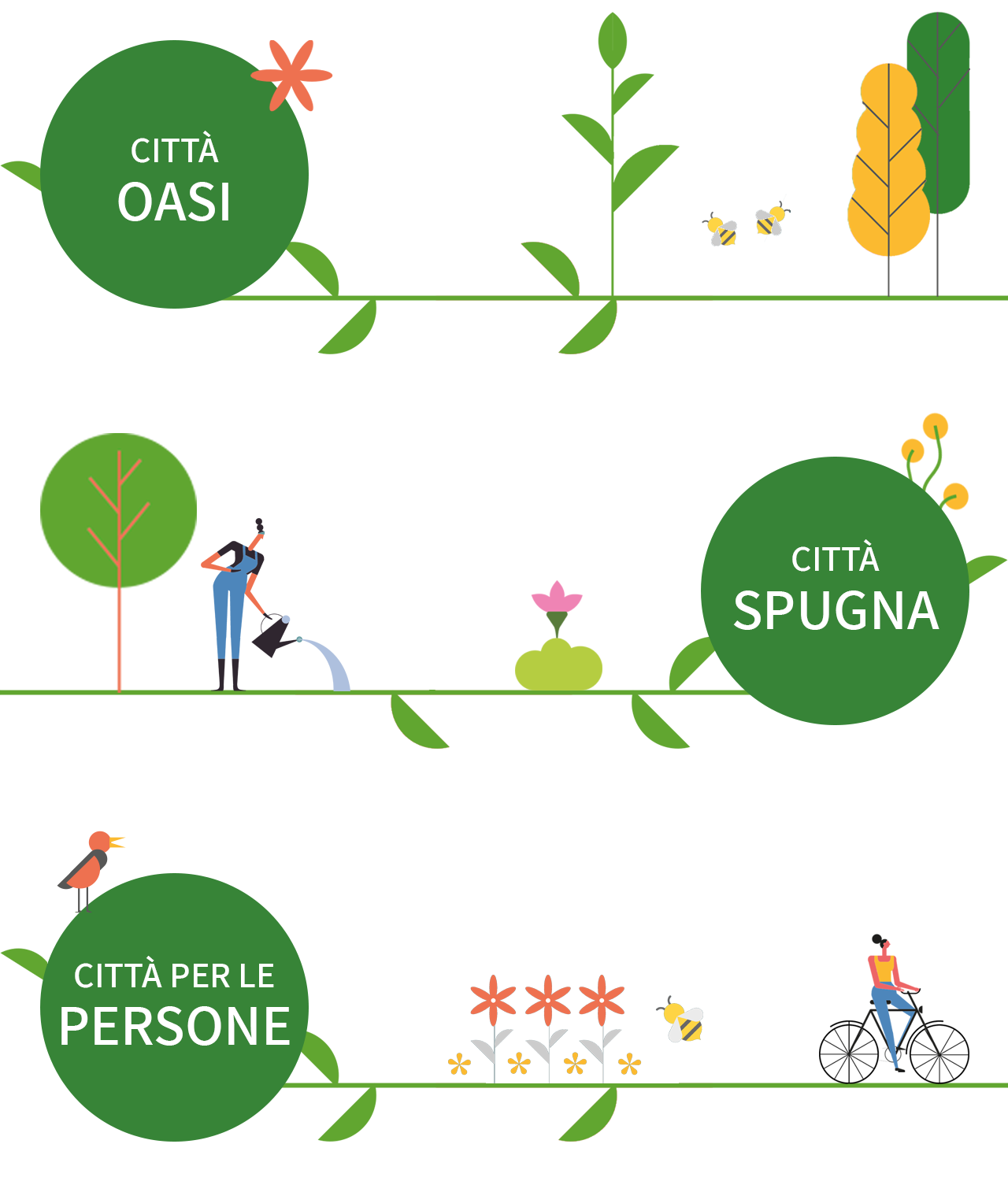Find out more
Download the document “Strategia di transizione climatica di Brescia”
The Climate Transition Strategy, approved by the Consiglio Comunale of Brescia in 2021, is a flexible policy instrument to achieve, over a period of thirty years, the challenging objectives of a climate transition, with a focus on increasing environmental sustainability and strengthening the resilience of Brescia community and its territory.

The Climate Transition Strategy sees its first implementation with the project Un Filo Naturale, developed by the Municipality of Brescia in partnership with AmbienteParco, Fondazione Centro Euro-Mediterraneo per i Cambiamenti Climatici and Parco delle Colline di Brescia, thanks to the contribution of Fondazione Cariplo and Regione Lombardia.
This is a systemic project which, in line with the strategic vision and with the objectives of achieving a greater urban and social quality, implements some thirty pilot actions aimed at producing and enhancing adaptation strategies, mitigation and resilience of the city, also pursuing the welfare of citizens.


The project therefore aims to promote adaptation and mitigation to climate change in urban and peri-urban environments, increasing knowledge on climate change issues among citizens, stakeholders and policy makers, activating processes of participation.
Actions to cope with heat waves, create shade, refresh, improve the urban microclimate and promote biodiversity
1.1 Support to the revision of territorial governance tools
The action consists in activities aiming at the elaboration of updates and integrations of relations, norms, planning guidelines, cartographs, procedures and regulations of current planning tools, such as the Piano di Governo del Territorio (PGT), in its various articulations, the Regolamento Edilizio (RE), the Piano della Mobilità Sostenibile as also of tools whose drafting is ongoing or is planned, including the Piano d’Azione per l’energia sostenibile e il clima (PAESC), the Piano Comunale del Verde and the Piano Pluriennale degli Interventi dei PLIS of the Municipality of Brescia.
1.2 Analysis of local climate variability
To support the revision of urban planning tools, CMCC Centro euro – Mediterraneo sui Cambiamenti Climatici has carried out for the Amministrazione Comunale of Brescia the analysis of local climate variability, namely of the climate specific characteristics, both related to the recent past and to the future (through high resolution climate projections). The analysis allows the identification of the main local climatic issues, in order to determine and plan targeted project actions, of which the chapter related to the TCS cognitive framework is a synthesis.
2.1 Urban redevelopment in a resilient perspective (depaving and oasis areas)
This action involves the redevelopment of urban spaces in terms of climate resilience through the implementation of depaving and the creation of green spaces (oasis areas). The depaving interventions will aim to replace the existing impermeable surfaces with permeable areas, through the use of Nature Based Solution. The intervention areas will be identified during the implementation of the action.
2.2 Construction of pilot green roofs
This action, of an experimental nature, involves the creation of some pilot green roofs on some public buildings and the development of studies and tools useful not only for their dissemination, but also for the management and publication of data and information. In this regard, the action provides for a botanical, ecological and territorial study to define specific design guidelines in a resilient perspective and to encourage the increase of biodiversity in the city through the construction of new urban habitats.
2.3 Renewal of city road trees with resilient plants
The planned interventions are concentrated in the district of Mompiano, located in the northern area of the city near the football stadium.This action consists of two interventions: removal of some of the rows of old trees at the end of their cycle, for a total of 182 trees, with renewal of these trees and integration, where possible, of the failures, for a total of 330 new trees; replacement of 200 sqm of impermeable surfaces (asphalt, concrete, tile) with herbaceous roofs.
2.4 Responsible forest management based on the construction of an associated governance model
The action aims to build an active and responsible management of the forests on Monte Maddalena. This action provides for the construction of an associated management model in which private owners are also involved, planning and implementing a set of pilot forestry works, for an estimated area of about 40 hectares. This tool will also form the basis for the activation of a sustainable forest certification path.
2.5 Reduction of pollution risk and improvement of the environmental quality of agricultural areas in the south of the Caffaro plant
In the intervention area, any form of agricultural production is prohibited and only the mowing of the plots is allowed without any possibility of harvesting the biomass, which must be left on site. This practice, initially carried out at irregular intervals by land owners, has caused a general reduction in plant biodiversity due to the spread of a few perennial species that tended to spread in abandoned areas. The project action instead involves cutting biomass (mulching) 3-4 times a year, biomass chopped and left on site to form a litter rich in organic substance that increases soil fertility and allows to contain the leaching of chlorinated organic pollutants, store carbon and then mitigate climate change. It is then planned to build an agro-eco-systemic model to identify future scenarios for the area where to reconcile the practice of mulching with other interventions to strengthen the ecosystem functions of SIN itself, in conditions of safety for the environment and citizens.
2.6 Design of pilot actions to reduce the risk of flooding of RIM channels
The action is aimed at reducing the criticalities of the minor water network of the city of Brescia that manifest themselves especially during extreme rainy episodes. It provides for the design of one or more pilot interventions, which can then be repeated in other sites. After having identified the critical areas and defined the intervention priorities, two territorial areas will be identified on the basis of this mapping, in order to carry out the design of as many water rolling tanks and thus reduce the risk of flooding.
2.7 Reforestation activities and establishment of new habitats to enhance the local ecological network
Reforestation interventions have been carried out in two peri-urban areas, with native arboreal and shrubby species favorable to the avifauna and entomofauna; the first area is located in Sanpolino and consists of several zones for a total of 3 hectares, the second is located near the San Polo Parco metro station, within the PLIS delle Cave and consists of several areas for a total of 7 hectares of land.
Interventions for the establishment of new habitats, mainly characterized by blooming meadows, has resulted in about 2 hectares including lawn, bushes and orchard, located in via Volta and via Acerbi / via Pinzoni, and in 1 hectare of bushy lawn and wet area at the roundabout in via del Serpente.
3.1 One Stop Shop
A window has been created to promote, both in the public and private sectors, decarbonization projects based on energy efficiency, reduction of energy consumption and the use of renewable sources, also by facilitating the establishment of renewable energy communities (CERs) and collective self-consumption groups (AUC).
3.2 Zero Energy District via Milano
In close synergy with the A2A multiutility, in Via Milano, a network of district cooling will be created for the new Borsoni Theatre, which is also associated with a photovoltaic system; the system will also be able to power other public and private buildings nearby, in a logic of district hub of cold supply zero emissions.
3.3 Incentives for a sustainable mobility
Innovative reward systems for the most virtuous behaviors to encourage sustainable mobility: the City of Brescia has introduced in the Piano Urbano della Mobilità Sostenibile (PUMS) the theme of integrated charging for all transport systems and the desire for a development of a reward system that will be implemented concretely starting from existing apps (such as BRESCIAPP).
Increased ability to develop project ideas and competitive partnerships to access national and international funding programs supporting the implementation of activities and interventions provided by the STC: to this end, the municipal administration will promote participation in calls for funding (H2020, Life, or other national funding programs) in order to implement those actions which cannot be financed directly.
The action aims to implement specific activities of detection and systematization of data and information on the microclimate and natural capital. These are disseminated through the platform of the Museo di Scienze Naturali, for the creation of a catalogue of meteorological information linked to the urban microclimate, based on the continuous acquisition of data monitored by meteorological stations.
The action aims to improve the skills and tools available to public actors involved in the management, implementation and monitoring of the TCS: the action intends to develop Capacity Building pathways, thanks to the collaboration with other local administrations able to provide consolidated and innovative examples about the management of the ongoing change.
7.1.1 Communication Plan
The action aims to develop an innovative Communication Plan through the brand definition brand and the identification of communication channels and tools to be used: in particular, there are plans to create a logo and a brand manual, as well as to define and manage digital and other communication channels, to coordinate the direction with the Press Office of the City of Brescia, to create and promote a video presentation of the project.
7.1.2 Developing a platform to raise awareness of climate change
Creation of an interactive platform of communication and collaboration with the citizens and with the scientific associations of the territory, focusing on adaptation to Climate Change and the ongoing strategies for its containment. The space of the platform dedicated to the STC provides for the constant updating of the actions foreseen in the project involving the whole partnership, and it will be integrated into the website of the Museo di Scienze Naturali.
7.1.3 Internal communication on the implementation of the Strategy
This action is aimed at sharing the information related to the progress of the project: it is therefore planned to to build a container (dashboard) to allow the internal offices of the Municipality and all partners to keep up to date on the progress and developments of the actions themselves.
7.1.4 Network for the visibility of the STC
The action refers to the adhesion to different networks, both national and international, as well as to the participation in conferences and recurring events in which CMCC has been involved for years, such as the European Climate Change Adaptation Conference (ECCA), the Climate Europe Festival, the thematic weeks of the European Union (e.g. Green Week), the conferences of the Covenant of Mayors or even the ONU agencies (e.g. UNFCCC, UNEP, UNEP FI, etc.).
7.2.1 Design, revision and set up of Parco della Biodiversità
The action consists in the set up of Parco della Biodiversità of the Museo di Scienze Naturali, to share with the citizens information on the role of the “Urban Forest” and on the forestry activities in the city within the fight against climate change.
7.2.2 laboratories and in-depth courses on climate changes
The action provides for the organization of laboratories and in-depth courses on climate change adaptation, addressed to schools and citizens, with the general objective of expanding the awareness and complexity of the environmental themes related to both the project and, in a wider perspective, the environmental and ecosystem culture.
7.2.3 Initiatives of Citizen Science
Citizen science campaigns are intended to raise awareness of the value of natural capital and of its importance for the well-being of communities: thanks to the GERT (Biodiversity Brescia) campaign activated in the APP CSMONLIFE every citizen can easily contribute to the collection of naturalistic data simply taking a picture of a tree, a flower, an insect or any animal and sending the photo via APP.
7.2.4 AmbienteParco set up and guided tours
The action involves the updating of AmbienteParco set ups and the organization of guided tours to the installations on issues related to climate change; regarding the organization of guided tours, the Ufficio Territoriale Scolastico will be involved to propose possible educational activities.
7.2.5. AmbienteParco experiential activities in cultural places
Updating of AmbienteParco experiential activities, such as scientific kits (boxes containing material for carrying out experiments) water, air, soil and energy themed, to be brought to schools through educational activities and training for students and schools in the area. Laboratories will be organized in the community places, such as libraries, schools, museums, all of public competence and management, in the territory of Brescia.
7.2.6 Development of the Parco delle Colline Visitor Centre
The action involves the creation of a visitor centre of the Parco delle Colline to explain the role of the park in mitigation (CO2 stocks), in adaptation to climate change (regulatory ecosystem services) and in the conservation of natural capital: the area identified is the former powder magazine of Mompiano, owned by the municipality; located in the north of the city and immersed in the green of the park.
7.2.7 Dissemination of the scientific content of climate variability scenarios and in-depth analysis
Dissemination action that is divided into thematic seminars for professional associations and companies and laboratories for students and citizens, with the results of the analysis of local climate variability (elaborated with Action 1.21); two distinct but complementary sub-actions, addressed to different types of users and aimed at the involvement of the entire local community.
7.3.1 Identification and mapping of stakeholders
This action consists in building a cognitive framework of citizens, relevant actors and stakeholders of the territorial context of Brescia, in relation to the themes and objectives developed by the project: the Consigli di Quartiere, active citizenship, environmental associations and committees, local institutions active in the field of formal and non-formal environmental education, research centres and training institutions of the territory, professional associations and colleges, businesses and territorial agencies in the various sectors, trade associations etc.
7.3.2 Organization of seminars for CC awareness and transformation of resilient urban collective spaces
The action describes at least two paths of study for stakeholders and citizens, with the presence of experts (external or internal to the partnership). At least two seminars are planned to be scheduled between 2022 and 2023, depending on the progress of other actions that may be related to them.
7.3.3 Development of listening and participation paths to identify places to be transformed and monitored
The action intends to to assess the degree of awareness of citizens on issues related to Climate Change: the methods of implementation include assemblies and meetings with citizens and stakeholders (to be articulated according to the different territorial areas) with particular reference to the indication of places in the city where it is possible to co-design new urban spaces in terms of climate resilience.
7.3.4 Process of participatory planning for resilient experimental transformation interventions
The action concerns a participatory planning process that sees the involvement of stakeholders and citizens of the different neighborhoods of Brescia, in the co-planning of interventions to transform urban spaces in terms of climate and social resilience, to be realized through participatory methods and urban experimentation.
Download the document “Strategia di transizione climatica di Brescia”